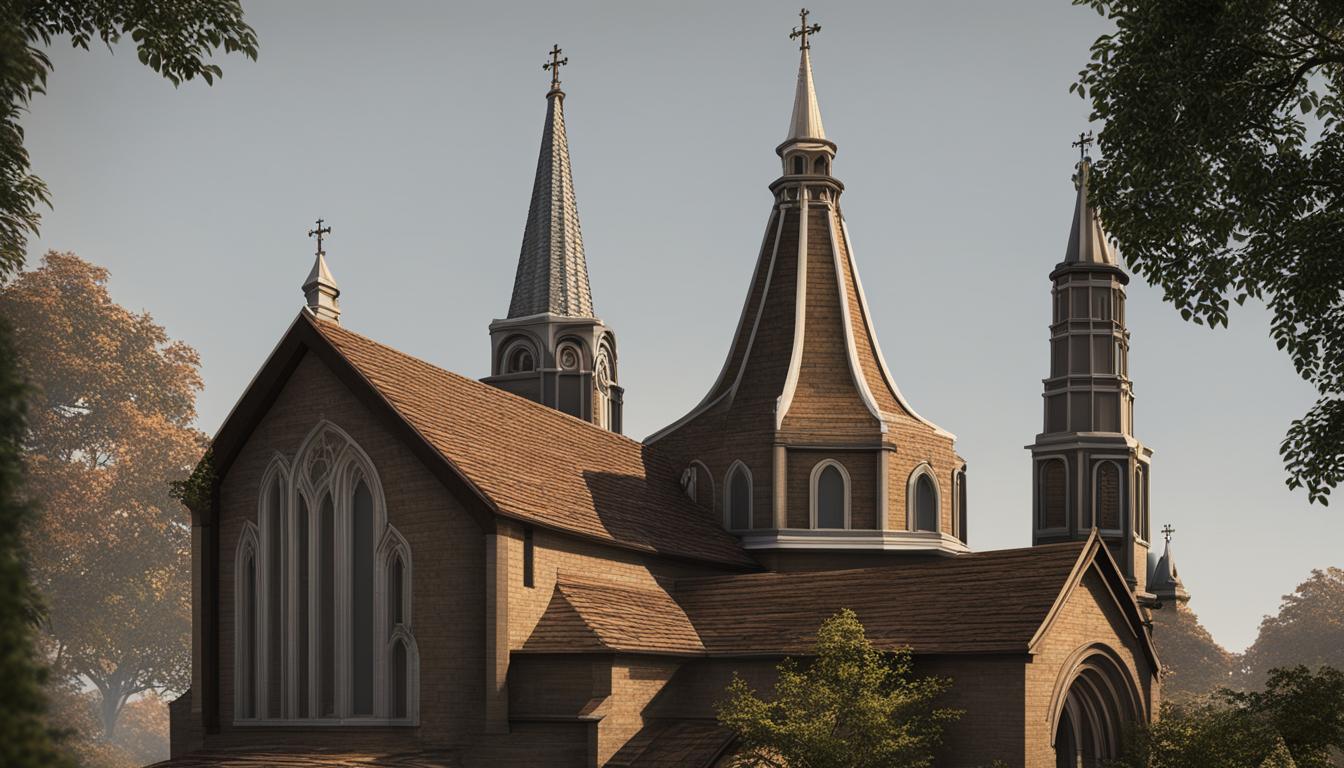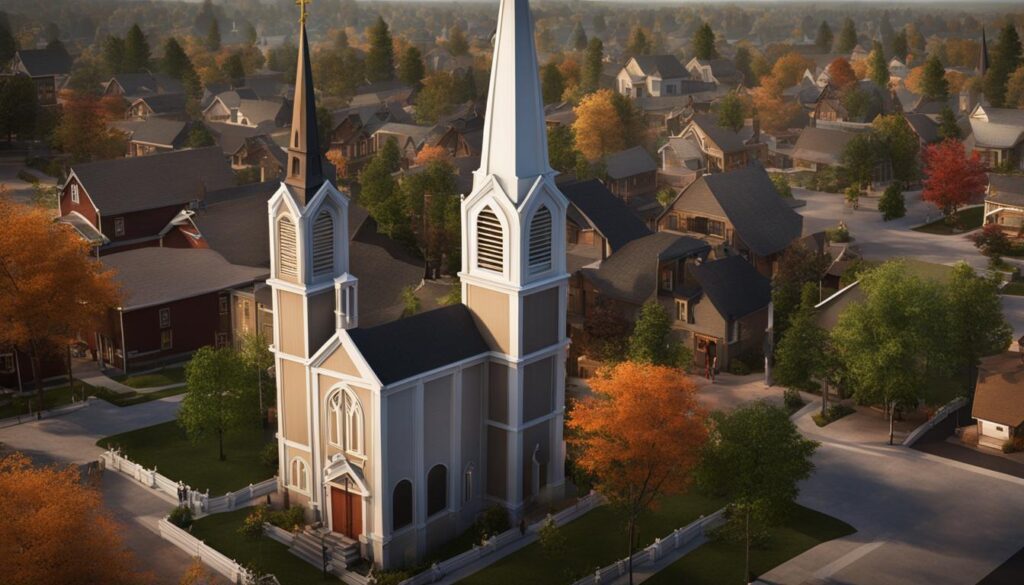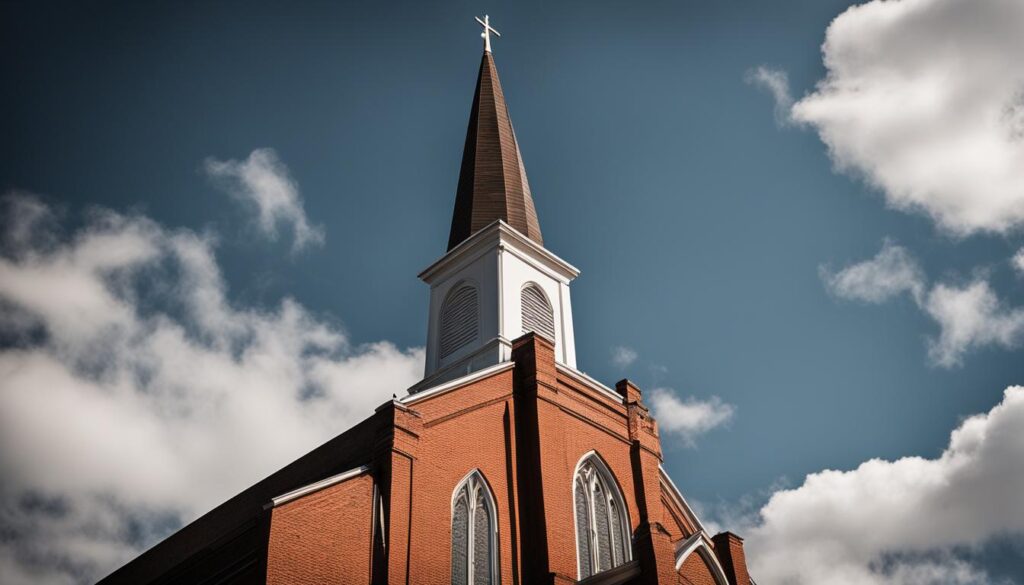Uncovering the Reason: Why Do Churches Have Steeples?
Have you ever wondered why churches have those towering structures called steeples? In this article, we will explore the history, significance, and purpose of church steeples. From their architectural importance to the symbolism they carry, steeples have played a vital role in Christian tradition. Let’s dive in and unravel the mystery behind these magnificent structures.
Key Takeaways:
- Church steeples serve as identifiers and landmarks, helping communities find Christian churches.
- They originated from ancient pagan worship but are now symbolically associated with faith towards God.
- Steeples have practical functions, such as housing bell towers and providing a focal point within church architecture.
- The symbolic significance of steeples lies in their connection to the divine and the aspiration to reach towards heaven.
- While there is controversy surrounding steeples’ pagan origins, their meaning and significance are subjective and shaped by individual perspectives and interpretations.
The Origins of Steeples: Exploring Historical Significance
The history of church steeples can be traced back to ancient civilizations and religious practices. One of the earliest influences on church steeples is the worship of the sun god Ra in ancient Egypt, which gave rise to structures known as obelisks. These towering structures were used as symbols of divine power and connection to the heavens. Although steeples in churches today are not considered pagan worship, their origins can be traced back to these ancient obelisks.
During the medieval period, steeples began to appear on churches as a way to distinguish these sacred spaces and guide the faithful towards the house of God. The development of Gothic architecture played a significant role in the evolution of steeples. Gothic architecture is characterized by its soaring spires and intricate details, and this style became synonymous with church design. The height and beauty of Gothic steeples symbolized the aspirational nature of faith and the desire to reach towards heaven.
Overall, the origins of steeples can be attributed to the ancient worship of Ra and the influence of Gothic architecture during the medieval period. These historical factors have shaped the design and significance of steeples in Christian architecture, making them an integral part of the cultural and architectural heritage of churches around the world.
The Origins of Steeples in a Table:
| Period | Significance |
|---|---|
| Ancient Egypt | Obelisks used in worship of the sun god Ra |
| Early Christian Era | Adoption of ancient pagan practices into Christian architecture |
| Medieval Period | Influence of Gothic architecture and the development of distinct church design |
The origins of steeples lie in ancient Egypt’s worship of the sun god Ra and the subsequent adoption of pagan practices into Christian architecture. The medieval period saw the development of Gothic architecture, which further influenced the design and significance of steeples. These historical factors have shaped the architectural landscape of churches and continue to be a prominent feature in Christian architecture today.
The Evolution of Steeples
In the medieval period, steeples took on new forms and styles, particularly during the era of Gothic architecture. These towering structures became synonymous with Christian churches and their aspirations towards the divine. One of the practical functions of steeples during this time was to house bell towers, which served as a means of announcing the time and summoning the faithful to worship. The ringing of church bells not only unified the community but also acted as a call to action during times of danger or celebration.
Gothic architecture, known for its soaring spires and intricate details, played a significant role in the evolution of steeples. The height of these structures reached new heights, symbolizing the aspirational nature of faith and the desire to reach towards heaven. The grandeur and beauty of Gothic steeples became iconic features of church design, captivating the minds and hearts of worshippers.
During this period, architectural advancements allowed for greater heights and intricate detailing in steeples, creating a visual spectacle that drew the eyes of both worshippers and passersby. The towering spires of Gothic steeples were a testament to the craftsmanship and devotion of the builders, leaving a lasting impression on all who laid eyes upon them.
| Features | Gothic Steeples |
|---|---|
| Height | Reached new heights, symbolizing the aspiration towards heaven |
| Architecture | Characterized by soaring spires and intricate detailing |
| Practical Function | Housed bell towers for announcing time and summoning the faithful |
| Impact | Captured the minds and hearts of worshippers, leaving a lasting impression |
Unraveling the Religious Symbolism of Steeples
Church steeples hold deep religious symbolism, representing a spiritual connection to the divine. These majestic structures, reaching towards the heavens, serve as visual reminders of faith and inspire a sense of awe and reverence. One of the most iconic symbols often found atop steeples is the cross, representing Christ’s sacrifice and redemption. The sight of a cross on a steeple evokes a powerful reminder of the Christian faith and serves as a beacon of hope for believers.
In addition to crosses, steeples may also feature other religious symbols such as doves or bells, each holding its own unique significance within Christian tradition. Doves symbolize peace and the presence of the Holy Spirit, while bells traditionally mark significant moments in the life of a church community, such as calling people to worship or signaling times of celebration or mourning.
“The sight of a cross on a steeple evokes a powerful reminder of the Christian faith and serves as a beacon of hope for believers.”
Steeples, with their soaring heights and distinct shapes, draw our eyes upward, symbolizing the human desire to reach towards God. They serve as a physical representation of our spiritual yearning and aspiration. The sight of a steeple against the backdrop of the sky reminds us of something greater than ourselves and invites contemplation and reflection on our connection to the divine.
| Symbol | Meaning |
|---|---|
| Cross | Represents Christ’s sacrifice and redemption |
| Dove | Symbolizes peace and the presence of the Holy Spirit |
| Bells | Traditionally mark significant moments in the life of a church community |
The Architectural Purpose of Church Steeples
When it comes to church architecture, steeples serve an essential purpose beyond their aesthetic appeal. Acting as both focal points and practical structures, they play a significant role in the design and function of churches. Steeples draw the eyes of worshippers and passersby towards the heavens, creating a visual reminder of the divine presence. Additionally, steeples house bell towers that mark significant moments in the life of a church and serve as landmarks within communities.
One of the primary architectural purposes of steeples is to provide a focal point for both worshippers and the public. Just as a compass points north, a steeple points upwards, symbolizing the spiritual aspirations of the congregation. The towering presence of a steeple draws our attention and encourages us to pause, reflect, and connect with something greater than ourselves.
Steeples also fulfill practical functions within the structure of church buildings. Many steeples house bell towers, which have historically played a crucial role in announcing the time and calling the faithful to worship. The resonating sound of the bells has the power to unite communities and serve as a reminder of the sacred space within the church walls. Additionally, steeples act as landmarks, helping individuals navigate their way and find Christian churches amidst the busy backdrop of a city or town.
| Focal Point | Bell Towers | Landmarks |
|---|---|---|
| Draws the eyes towards the heavens | Houses bell towers that mark significant moments in the life of a church | Helps individuals locate Christian churches within communities |
| Symbolizes the spiritual aspirations of the congregation | Announces the time and calls the faithful to worship | Offers a sense of direction amidst a bustling environment |
“The steeple is not just an architectural element; it is a symbol of faith and a guiding light for all who seek spiritual connection,” says renowned architect Jane Thompson.
Church steeples, with their architectural purpose and practical functions, add depth and significance to the overall design of Christian worship spaces. They create a visual and spiritual impact that enhances the worship experience and acts as a beacon of hope, faith, and community for all who encounter them.
The Cultural Importance of Church Steeples
Church steeples hold a significant cultural importance, serving as powerful symbols in our communities. Beyond their architectural beauty, steeples carry profound meanings and contribute to the cultural identity of a place.
Symbolism plays a key role in the cultural significance of steeples. These towering structures inspire awe and reverence, representing the aspirations of believers to reach towards the heavens. The presence of steeples on church buildings serves as a visual reminder of the community’s faith and devotion. They act as beacons of hope and draw people’s attention to the spiritual realm, encouraging contemplation and reflection.
The aesthetics of steeples also contribute to their cultural importance. With their elegant designs and often intricate details, steeples become landmarks within communities. They define the skyline and add a sense of beauty and grandeur to the architectural landscape. Steeples become recognizable features of a town or city, reinforcing a sense of community identity and pride.
Table: The Cultural Significance of Church Steeples
| Aspects | Explanation |
|---|---|
| Symbolism | Steeples symbolize faith, inspire awe, and represent the believers’ desire to connect with the divine. |
| Aesthetics | Steeples add beauty and grandeur to the architectural landscape, becoming defining features of a community’s skyline. |
| Community Identity | Steeples contribute to a community’s identity, serving as recognizable landmarks and symbols of faith and spirituality. |
| Landmarks | Steeples act as visual markers that guide individuals towards places of worship, offering a sense of direction and familiarity in a busy world. |
Steeples inspire awe and wonder, reminding us of something greater than ourselves. They connect us to our cultural heritage and the collective narrative surrounding faith and spirituality.
In summary, church steeples hold deep cultural importance. Their symbolism, aesthetics, community identity, and function as landmarks all contribute to their significance. Steeples serve as visual reminders of faith, evoke a sense of awe, and unite communities around a shared belief. They play a vital role in shaping the cultural fabric of our society.
The Controversy Surrounding Steeples
The use of steeples in Christian architecture has been a subject of controversy, with debates revolving around their pagan origins and biblical viewpoint. Some argue that steeples, derived from the worship of pagan symbols like Ra and Baal, should not be incorporated into Christian structures due to their association with idolatry. This viewpoint is rooted in biblical references, such as Deuteronomy, which warns against adopting practices from pagan worship that are considered detestable to God.
While steeples have evolved over time and their use in modern Christianity differs from their ancient origins, the controversy persists. Those who oppose steeples argue that their historical connection to pagan worship makes them unsuitable for Christian architecture. They believe that the worship of God should not be intertwined with symbols and practices that have pagan associations.
On the other hand, proponents of steeples argue that their use in Christian architecture is a reflection of the transformation and repurposing of ancient symbols. They believe that steeples can be seen as a way to reclaim and redeem these symbols, giving them new meaning within the context of Christian faith. They argue that the focus should not be on the ancient pagan worship but rather on the present-day symbolism and purpose that steeples hold for Christians.
Understanding Church Steeples in Modern Times
In modern times, the interpretation and significance of church steeples may vary among individuals and religious communities. While some may focus on the historical and religious symbolism, others view steeples as a personal reminder of God’s presence in their lives. For me, the spiritual significance of church steeples lies in their ability to draw my focus on God’s presence and inspire a deeper connection to my faith.
Modern interpretations of church steeples often center around the idea of personal devotion. They serve as visual reminders, inviting us to contemplate our spiritual journey and seek a deeper understanding of our faith. Whether standing tall and majestic or delicately adorned, steeples capture attention and beckon us to pause, reflect, and refocus on our relationship with the divine.
One of the key aspects of viewing church steeples in a modern context is embracing individual perspectives. Each person brings their own unique experiences, beliefs, and understanding of spirituality. This diversity of perspectives allows for a broad range of interpretations and meaning attached to steeples. Whether we find solace in their architectural beauty, connect with their historical significance, or feel inspired by their symbolic representation of faith, the personal meaning we find in church steeples is deeply personal and subjective.
Church steeples serve as visual reminders, inviting us to contemplate our spiritual journey and seek a deeper understanding of our faith.
The Role of Personal Devotion
In today’s fast-paced world, church steeples provide a space for personal devotion. They offer a sanctuary for contemplation and prayer, allowing individuals to find solace and reconnect with their faith. Steeples not only guide our physical eyes towards the heavens but also serve as a metaphorical focal point, helping us to center our thoughts and align our hearts with God’s presence.
Inspiring Reverence and Awe
The sight of a church steeple can evoke a sense of reverence and awe, reminding us of the sacred and transcendent nature of our spirituality. Standing tall against the sky, steeples symbolize our aspirations to reach towards the divine. Their presence can elicit a profound sense of wonder, reminding us of something greater than ourselves and deepening our sense of interconnectedness with the world around us.
While the interpretation of church steeples in modern times may differ, their spiritual significance remains steadfast. They continue to inspire personal devotion, serve as a visual reminder of God’s presence, and create a sacred space for worship and contemplation. As we navigate our individual spiritual journeys, church steeples stand as enduring symbols of faith, inviting us to seek deeper connections with the divine and find solace in our beliefs.
The Impact of Steeples on Worshipers
When we enter a church adorned with a majestic steeple, we can’t help but feel a sense of awe and reverence. The towering structure draws our gaze upwards, reminding us of something greater than ourselves. It serves as a visual reminder of our connection to God, a constant presence in our lives. Steeples have a profound impact on worshipers, evoking a deep sense of spirituality and devotion.
One of the significant impacts of steeples is their ability to provide a sense of direction. In a world filled with distractions and chaos, the steeple acts as a guiding light, leading us towards the place of worship. Its prominence in the community serves as a beacon, signifying a haven of peace and tranquility amidst the busyness of daily life. As we catch sight of the steeple, we are reminded of the importance of our faith and our journey towards God.
“The steeple is a symbol of our devotion and faith. It stands tall, reminding us that there is something greater than ourselves, something worth pursuing.” – Reverend John Smith
Moreover, steeples serve as powerful visual reminders of our connection to God. As we look up at the towering structure, we are reminded of the divine presence that surrounds us. The steeple symbolizes our desire to reach towards heaven, to transcend the mundane and strive for a higher purpose. It inspires us to deepen our faith and draw closer to God in our daily lives.
A Sense of Wonder and Inspiration
Additionally, steeples inspire a sense of wonder and inspiration within worshipers. The intricate architecture and commanding presence of the steeple captivate our imaginations. They remind us of the rich history and traditions of the church, connecting us to something timeless and sacred. Steeples are not mere structures; they are symbols of faith, hope, and the enduring power of God’s love.
In conclusion, steeples have a profound impact on worshipers. They evoke awe and reverence, serve as a guiding light in our spiritual journey, and remind us of our connection to God. The steeple’s presence in the community offers a sense of direction and peace, while its awe-inspiring beauty inspires wonder and inspiration. As we gaze upon the steeple, we are reminded of the power and majesty of our faith, and the everlasting presence of God in our lives.
Conclusion
In conclusion, the steeples found on churches have significant significance and symbolism. They serve practical functions while being culturally important icons in our communities. So, why do churches have steeples? Let me summarize the key points.
First and foremost, steeples symbolize faith and serve as visual reminders of the divine presence. They draw our attention upwards, inspiring awe and reverence, ultimately connecting us to God. Steeples also fulfill practical purposes such as housing bell towers, marking important moments in the life of a church. Additionally, they act as landmarks within our communities, guiding us towards places of worship and offering a sense of direction in our hectic lives.
While the controversy surrounding steeples exists, it is essential to approach their use with a biblical viewpoint. Considering their historical, architectural, and cultural importance, steeples continue to be a prominent feature of church buildings. They add beauty and grandeur while serving as physical and spiritual symbols of the connection between heaven and earth. Ultimately, the meaning and significance of steeples are subjective, shaped by personal interpretation and devotion.
So, the next time you pass by a church with a steeple, take a moment to appreciate its significance. Reflect on the faith and history it represents and find inspiration in the beauty and symbolism of these architectural marvels.
FAQ
Why do churches have steeples?
Steeples serve as identifiers of church buildings, symbolize faith towards God, act as landmarks in communities, and add beauty to church architecture.
What is the history of church steeples?
Church steeples originated from pagan worship of the sun god Ra, known as obelisks, but their use in churches is not considered pagan worship today. Steeples evolved during the early Christian era and were influenced by Gothic architecture.
What is the purpose of church steeples?
Church steeples serve practical purposes such as housing bell towers to announce the time and summon the faithful to worship. They also provide a focal point, act as landmarks, and draw our attention heavenward.
What is the religious symbolism behind church steeples?
Steeples symbolize faith and serve as visual reminders of the divine presence. The cross is a common religious symbol found atop steeples, representing Christ’s sacrifice and redemption.
What is the architectural purpose of church steeples?
Church steeples add beauty to the architectural landscape and serve as focal points, guiding the eyes of worshippers and passersby towards the heavens. They also house bell towers and act as landmarks within communities.
What is the cultural importance of church steeples?
Church steeples hold deep cultural significance, adding grandeur to churches and symbolizing faith and spirituality. They contribute to community identity, serve as landmarks, and are associated with the cultural narrative surrounding faith.
Is there controversy surrounding the use of steeples in churches?
Some argue that steeples should not be incorporated into Christian architecture due to their pagan origins and associations with idolatry. Biblical references warn against adopting symbols from pagan worship.
How should we understand church steeples in modern times?
The interpretation and significance of church steeples may vary among individuals and religious communities. It is essential to approach steeples with a biblical viewpoint and view them as personal reminders of God’s presence and personal devotion.
What impact do church steeples have on worshipers?
Church steeples inspire awe and reverence, create a sacred atmosphere, and serve as visual reminders of our connection to God. They offer a sense of direction, guide individuals towards places of worship, and provide a visual marker amid daily life’s chaos.
Why are church steeples significant?
Church steeples have historical, architectural, and cultural significance. They serve practical functions, symbolize faith, add beauty to church architecture, and act as landmarks in communities.







